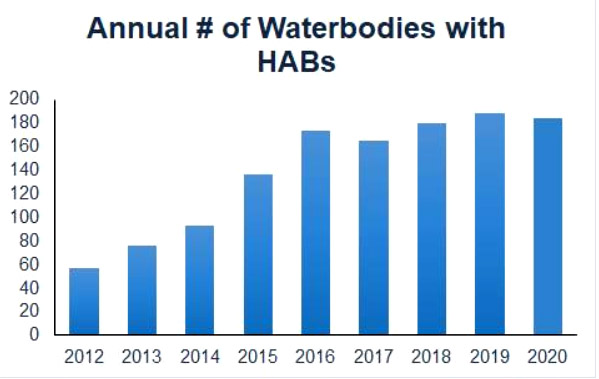|
|

|
  
2021/6/3
HABs
An overview of the Harmful Algal Blooms (HABs) situation in New York
WTNY Staff
WTNY reached out to DEC and DOH for an update on the HABs situation for Summer 2021. Here is their reply.
Safeguarding New York's water quality is a top priority and the State is providing direct assistance to communities to swiftly and effectively respond to harmful algal blooms, (HABs). Department of Environmental Conservation (DEC) scientists and Department of Health (DOH) experts are working closely with state and local partners to investigate the causes of HABs across the state and are pioneering cutting edge solutions to respond to these blooms and the threats they pose to public health and the environment, namely New York's drinking water supplies
BACKGROUND
At Governor Cuomo's direction, DEC and DOH are leading a multi-agency, statewide initiative to aggressively combat HABs and protect drinking water quality and the economy. In 2018, four summits brought together national, state, and local experts to discuss how to reduce the frequency of these blooms.
DEC and DOH partnered to establish the most comprehensive HAB surveillance and alert program in the country. HABs Action Plans for 12 high priority waterbodies were prepared on an accelerated basis by DEC in close coordination with local steering committees. In New York State, drinking water advisories are issued through local health departments and water systems and DOH provides consultation for these notifications as needed.
To date, New York has awarded more than $187 million in grants to projects designed to reduce the frequency of algal blooms across the state by targeting phosphorus and nitrogen pollution, controllable factors that trigger HAB occurrences. In collaboration with numerous partners, DEC is advancing over $11 million towards research and development, pilot projects, and advanced monitoring to address HABs. In addition, waterbody-specific “HABs Action Plans” are being cooperatively implemented at priority waterbodies across the state and advanced monitoring for nutrient drivers and HABs indicators has been conduc
ted in 175 lakes.
In June 2019, New York State launched a new online HABs map and reporting system for the public. Dubbed "NYHABS," the reporting system features an interactive map that is updated daily with reports of HABs, as well as a new public reporting form.
DEC encourages New Yorkers to “KNOW IT, AVOID IT, REPORT IT.” KNOW IT – naturally occurring harmful algal blooms, ‘HABs,’ vary in appearance from scattered green dots in the water, to long, linear green streaks, pea soup or spilled green paint, to blue-green or white coloration. AVOID IT – People, pets and livestock should avoid contact with water that is discolored or has algal scums on the surface. REPORT IT – If members of the public suspect a HAB, report it through the NYHABs online reporting form available on DEC’s website.
HABs can cause health effects in people and animals when water with blooms is touched, swallowed, or when airborne droplets are inhaled. For more information please visit NYS Department of Health's HAB page. Symptoms or health concerns related to HABs should be reported to DOH at harmfulalgae@health.ny.gov. The public is encouraged to contact the local health department with any reports of health effects (human or animal). We recommend contacting county health departments.
HABs are likely triggered by a combination of water and environmental conditions that may include: excess nutrients (phosphorus and nitrogen), lots of sunlight, low-water or low-flow conditions, calm water, and warm temperatures. Depending on the weather and the characteristics of the lake, HABs may be short-lived (appearing and disappearing in hours) or long-lived (persisting for several weeks or more). While the exact cause of HABs is not fully understood, HABs usually occur in waters high in phosphorus and/or nitrogen. New York State has many programs and activities to reduce phosphorus and nitrogen from entering the water from surrounding lands, including stormwater permitting programs, funding for water quality improvement projects, and a nutrient law that restricts the use of phosphorus lawn fertilizer. Please find additional info on HABs from DEC’s website http://www.dec.ny.gov/chemical/77118.html
2020 HAB season compared to previous seasons: The total number of waterbodies with HABs in 2020, reported through NYHABS, is similar to the last few years, but included several new waterbodies that have never had a HAB before. Because of COVID-19 HAB sample collection was somewhat reduced in 2020, but overall the level of bloom reporting was not lower than previous years.

|
|
All rights reserved 2025 - WTNY - This material may not be reproduced in whole or in part and may not be distributed,
publicly performed, proxy cached or otherwise used, except with express permission.
|
|